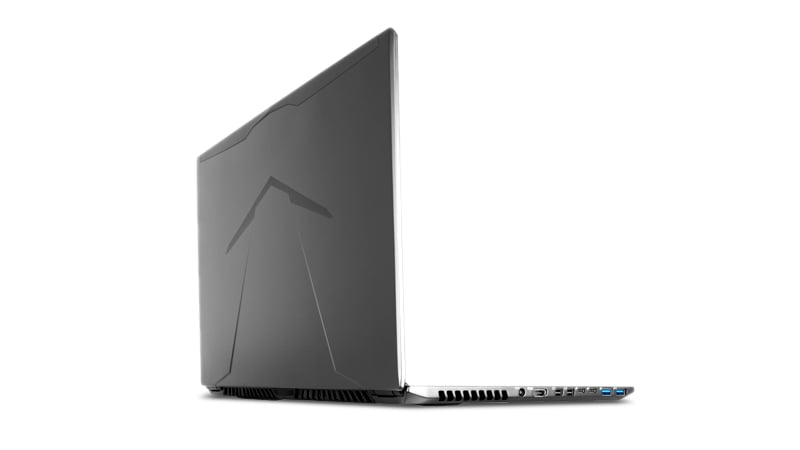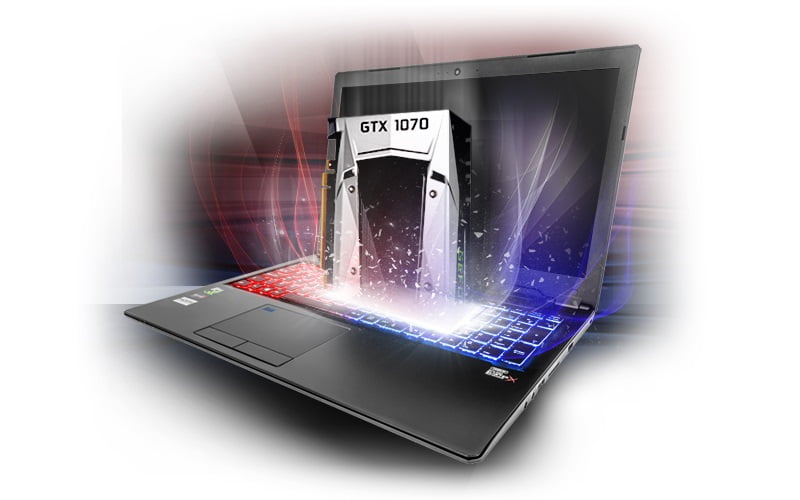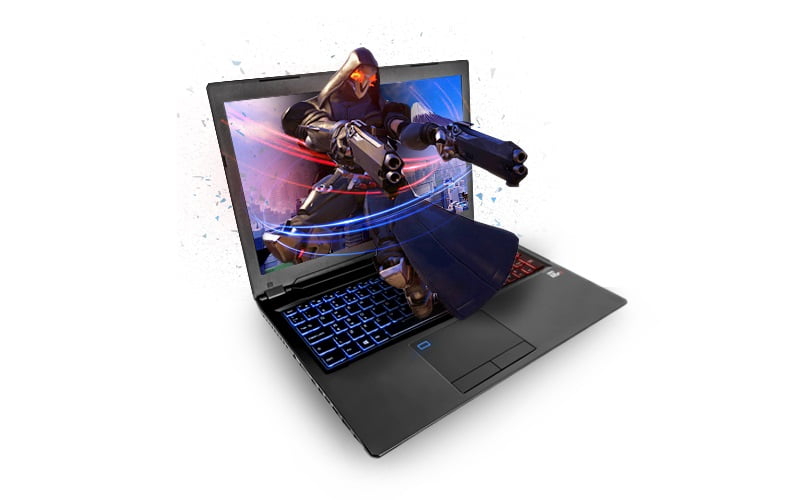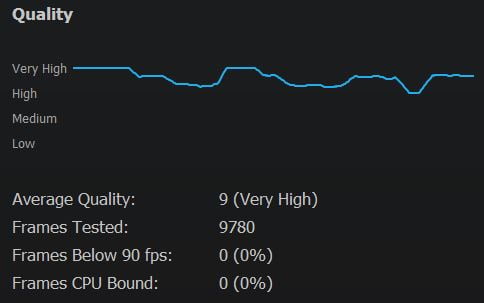Our laptop reviews are a little different to most.
Where magazines will be meeting deadlines and tech blogs will be trying to be first, we take our time. Yes, there’s value in rapidly running a dozen benchmarks, testing the battery life, measuring the noise levels, and then getting your review to the top of the Google queue; but we chart an alternate course.
The last time I bought a car – back in 2011; you don’t get rich in games journalism – it wasn’t the first drives or the test day reviews that persuaded me. It was a 100,000 km road trip road test, where a determined tester took the vehicle on a circuitous route around Europe, finally ending up at the factory the car was built at for a once-over after just over 62,000 miles.
TL;DR: One of the tiny bulbs above the rear number plate had failed. That was it. I was sold. (Both on the car, and the long-form review methodology.)
With that in mind, I’ve been using the PC Specialist Defiance XS laptop – a super-thin 15.6″ gaming laptop, with an Nvidia GTX 1070 Max-Q GPU – as my day-to-day machine for almost ten weeks. How does it shape up to such an extended period of testing?
1. Design

The Defiance XS is, for the components inside – full spec below – remarkably thin and light. It’s not quite Razer Blade small, but for a laptop packing a 15.6″ screen, it’s impressive: it’s just 18.6 mm thick, for one thing. And that’s a proper 18.6 mm, all the way across; not with a super svelte scalloped front edge where the thickness measurement is taken, with a hefty hinge holding all of the core components. This laptop is genuinely 18.6 mm thick.
It also weighs just 1.9 kg in its base configuration. There’s no touch screen option here, which would add weight to the panel, but you will still probably push the build up over 2 kg by adding a mechanical hard drive instead of (or in addition to) a featherweight M.2 SSD, more sticks of RAM, and picking a GTX 1070 Max-Q GPU (over the base GTX 1060 Max-Q card).
That’s because the Defiance XS comes from UK custom laptop builder PC Specialist, and thanks to their handy on-site configurator, you can put together whatever build you like for the Defiance XS. That price could range from under a grand – with just 4 GB of RAM, no hard drive, and no OS license; perfect if you have the parts to kit it out yourself – up to a wallet-wincing three grand, if you go for 32 GB of RAM and a stupendous 4 TB of SSD storage.
Because this is from a custom builder – how can I put this politely? – you would be forgiven for thinking it may not be… the most attractive device. Where big vendors can produce custom designs on what are basically the same OEM chassis, custom system builders typically receive them in ‘stock’ configuration from Clevo or Sager. There are some ugly laptops out there from custom shops, through a combination of price point and “gamer” aesthetics, but the Defiance XS is quite lovely.
It doesn’t scream “gamer” at you at the top of its lungs, though. It has some of the things you might expect from a gaming laptop – like a lot of vents, an RGB keyboard, a proper number pad, and some accents on the WSAD keys – but it’s all tasteful and understated. The vents are slim and unimposing; they don’t look like the exhaust pipes on a battleship. The RGB lighting is subtle, almost pretty; though you can go nuts with the light show, if that takes your fancy. The WSAD keys just have four discrete arrows on them.
The Defiance XS looks great, and with a cool grey aluminium finish that is remarkably resistant to fingerprints, it feels as good as it looks.
But just because this is a stylish, muted gaming laptop, it doesn’t mean the Defiance XS doesn’t come with something of a party piece, a flashy nod to its gaming roots:
It’s like the Bat Signal in laptop form, and let’s be honest, a far better implementation of a backlit lid detail than a glowing Apple.
2. Build quality

After more than two months with this laptop, working it very hard on a daily basis, it still feels remarkably solid. This laptop has played dozens of hours of games, written tens of thousands of words, and has travelled hundreds of miles with me, and it’s still all in top nick.
Seriously, this is going to be a very short section on build quality, because it speaks for itself.
Normally I have at least something to complain about here, even if its incredibly minor – hinge a bit too loose (or too stiff), keyboard deck too bouncy, trackpad buttons a little spongy – but I’m really struggling to come up with any gripes with the Defiance XS.
Erm, right.
The ethernet port – which in a laptop this thin is as rare as rocking horse faeces – is a little tight. It’s one of those ones that has a little fold down covering flap, so that there isn’t an open notch along the bottom edge of the laptop that you could catch on something and crack the chassis? If you have a fully booted ethernet cable in the port and the laptop is on a flat surface like a desk, you have to lift up the right hand side of the laptop slightly to unplug the cable, because the covering flap can’t open far enough below the laptop to release the RJ45 jack.
So essentially, the laptop is too thin for an ethernet port, but they included one anyway, and it’s very slightly inconvenient to unplug if you’re on a desk and not your lap.
What else?
The keyboard and trackpad, which are plastic rather than aluminium, of course, aren’t as fingerprint resistant as the rest of the chassis. The keyboard is comfortable to use for both typing and gaming, and the trackpad and buttons are very responsive – possibly slightly too sensitive on gesture recognition, if anything; it’s easy to zoom in/out of webpages when you’re trying to scroll – but they are more prone to picking up grease and dirt than the rest of the laptop. I haven’t worn away any of the keyboard lettering, nor have I pounded the trackpad buttons into submission, but you can definitely see hot spots around the WSAD keys and the space bar.
So yeah, when you use a laptop for hundreds of hours in a two-month period it shows a few signs of use, is the key takeaway here.
I’m really reaching here. Sorry.
3. Specs

Because the Defiance XS is a custom shop build from PC Specialist, you can tweak the configuration to suit your budget and expectations. And because PC Specialist were sending this out for review, they sent us a high-end one. You can’t blame them: they want us to see the machine at its best.
Here’s the full configuration that we’ve been reviewing for the past two months:
- Operating System: Windows 10 Home
- Processor: Intel Core i7-7700HQ 2.8 GHz/3.8 GHz turbo; Quad-core
- Chipset: Intel HM175
- Memory: 16 GB Corsair 2400MHz SODIMM DDR4 (up to 32 GB maximum)
- Storage: 1 TB Seagate Firecuda SSHD hard drive; 256 GB Samsung M.2 NVMe SSD
- Screen: 15.6″ Full HD (1920×1080) 120 Hz IPS panel
- Graphics: Nvidia GeForce GTX 1070 Max-Q 8 GB (GTX 1060 Max-Q 6GB variant also available)
- Connectivity: Gigabit LAN; Wireless Intel AC-8265 M.2 (867Mbps, 802.11AC); Bluetooth 4.0
- Audio & Video: 2 MP full HD webcam; Soundblaster X dual speakers
- Ports & Connectors: 1 x HDMI Port, 2 x Mini Display Port; 3 x USB 3.1 Type A, 2 x USB 3.1 Type C; Dual headphone/mic jacks; multi-card reader
- Battery: Integrated 4 cell 55Wh
- Battery Life: (up to) 5 hours
- Adaptor: 150 W external
- Dimensions (W x D x H): 380 mm x 249 mm x 18.6 mm
- Weight: 1.9kg base; configured 2.2 kg (approx.)
As mentioned above, the online configurator provided by PC Specialist allows you to go as high or low as your budget affords. The model we’re testing comes in at an MSRP of £1,633, though you can configure one for less. Or more. The choice is yours, really.
4. Power, cooling, and noise

There are widely considered to be three drawbacks with Nvidia’s Max-Q mobile graphics cards:
- They’re slightly less powerful than their full-fat desktop brethren.
- They can be known to run hotter and louder than non-Max-Q laptops.
- They can lead to some funky keyboard/trackpad positions, to compensate for their unusually thin design.
Thankfully, number three isn’t an issue here. The Defiance XS has a thoroughly standard keyboard/trackpad layout, in spite of PC Specialist cramming a GTX 1070 Max-Q into an 18.6 mm thick chassis.
Numbers one and two, however? They’re definitely in play.
The differences between full-fat GTX and the GTX Max-Q graphics cards are well-documented, and it’s the same with the GTX 1070 Max-Q. While they might be an identical GPU – with the same GP104 architecture, the same 8 GB of GDDR5 RAM, and the same memory bandwidth of 256.3 MB/s – the Max-Q variant is down-clocked from 1,506 MHz to 1,215 MHz on the base frequency, and from 1,683 MHz to 1,379 MHz on the turbo clock. This is to reduce the heat output and cooling requirements of the GPU, designed for super-thin mobile devices like the Defiance XS, but also brings the peak power consumption down from 150 to 115 W. You can check out the full differences on GPUBoss.
Will you notice, in real terms? Probably not. If you sat the Defiance XS, with its GTX 1070 Max-Q GPU, down next to a desktop machine with a ‘full’ desktop GTX 1070 you’d definitely see a difference of a few frames, but we’re talking about the TV-buying phenomenon again.
Not familiar with this analogy? When you’re in an electrical store, agonising over which of the forty tellies on the wall in front of you has the best picture, scrutinising them all in minute detail for flaws, it seems like the most important decision in the world. But when you get your new TV home, it’s usually the only one in the room (unless you’re weird). You’re not comparing it to forty other televisions on a daily basis: the one in your living room will be the best TV you can see, and it’s the same with the GTX 1070 Max-Q.
Yes, it’s a little slower than the desktop version, but unless you’re planning on playing two machines side-by-side (which, again, would be weird, unless you’re a professional reviewer) you won’t even notice. It will still kick the stuffing out of almost any other mobile GPU; particularly in this small a form factor.
Having a powerful GPU like GTX 1070 – even in its pared back, Max-Q variant – in a very thin laptop like the Defiance XS does have a bearing on noise and heat, however.
Like most gaming laptops, the Defiance XS draws cool air in from under the laptop, through fans and across heat pipes, and out of the vents on the rear of the laptop. Because the Defiance XS is so thin, those fans have to be very small, in PC component terms. And not only are smaller fans generally louder than bigger ones, they have to operate at higher frequencies to push the same amount of air, which makes them louder again.
It’s not loud at all during every day use, but the fan noise is very noticeable when the system is under load, and because there’s very little thickness of material on the bottom of the chassis between the hot components and your lap, it does get rather warm underneath.
The design of the Defiance XS is such that, mercifully, the keyboard, trackpad and palm rests never get hot, no matter what we throw at this laptop. The underside and rear vents, on the other hand, could cook your thighs if you’re not careful. The GPU peaks at around 73°C after an extensive gaming session, which isn’t a critical GPU temperature by any means – and is impressive for a device this thin and powerful – but it’s definitely on the toasty side. Using it on a desk is fine, but if you’re gaming with it on your lap we’d recommend a lapdesk – preferably one with a ventilated mesh or built-in fan, so that it doesn’t obstruct the cool air intakes under the laptop – or at the very least, a cushion.
It also uses a lot of power, when under load. Because PC Specialist is a system builder that tends to focus on gaming, the Defiance XS doesn’t come configured with any kind of extreme power-saving out of the box. It also doesn’t come with any bloatware or undesirable software, either; another benefit of a bespoke shop over big manufacturers. But because of this full throttle approach, the Defiance XS won’t get anywhere near that stated five hour battery life in its default state.
The compact chassis dictates the battery has to be relatively small for such powerful internal components – that GTX 1070 Max-Q and a desktop Core i7 processor – so you might find that the battery life feels weak. Typically, we’ve achieved two to three hours of battery life during productivity tasks, and one to two hours during intensive use. If you adjust the power management to closer resemble the bigger manufacturers settings (and Windows defaults) you might stretch that productivity use past three or four hours, but you’ll never want to be far from an electrical outlet when you’re gaming.
5. Performance, usability

First up, some real world gaming benchmarks. We don’t perform synthetic benchmarking – you can find that sort of stuff online very easily – but like to include real world gaming figures, because they’re useful at a glance and many of the games make familiar frames of reference.
1080p benchmark data:
- Batman: Arkham City (extreme preset) – 78 fps
- BioShock Infinite (ultra preset) – 102 fps
- Final Fantasy XV (high preset) – 50 fps
- Gears of War 4 – (ultra preset) – 61 fps
- PUBG (medium settings, ultra draw distance, 1080p) – average 70 fps in quiet zones / 45 fps in busy zones
This was all done as per our usual testing methodology. For the games with built-in benchmarking tools, we ran the tests five times and calculated the mean average. For PUBG, which is so variable it’s damn-near impossible to benchmark accurately, we played about 60 hours and worked out rough averages based on what we’ve seen during different play conditions in that time.
As we pointed out in the previous segment, with regards to the differences between a stock GTX 1070 and the Max-Q variant designed for ultra thin gaming laptops, you might get slightly lower frame rates than the desktop equivalent. But with figures like that for 1080p gaming – and keeping in mind the TV store analogy – it’s very hard to argue that the configuration inside the Defiance XS makes for an extremely capable machine.
You can also purchase the Defiance XS with a 4K IPS panel, for an extra £89. Our review model has a 1080p display but with one HDMI and two mini display ports, there’s nothing to say we can’t drive a 4K display with it. That increased resolution obviously has a knock-on effect on performance benchmarks, however.
2160p (4K) benchmark data:
- Batman: Arkham City (extreme preset) – 55 fps
- BioShock Infinite (ultra preset) – 58 fps
- Final Fantasy XV (light/standard preset) – 36 / 24 fps
- Gears of War 4 (low/med/high preset) – 49 / 38 / 34 fps
- PUBG (medium settings, ultra draw distance) – average 26 fps in quiet zones / 20 fps in busy zones
Those aren’t terrible figures, and the Defiance XS can handle 4K admirably if you’re prepared to climb down from the very highest settings, but 1080p is probably the sweet spot for most users.
The Defiance XS is also a very capable VR machine. It features two USB 3.0 ports on the front left edge of the laptop, situated very close to the HDMI port, which is ideal for the cabled setup employed by most virtual reality headsets. The laptop also monstered the Steam VR and Windows Mixed Reality performance requirements, and was generally flawless during our VR testing.

The Defiance XS makes for an excellent creative machine. We spent some time developing some of our typically over-ambitious and poorly-optimised scenes in Unity – we’re enthusiastic amateurs who like a lot of grass and trees – which it gobbled up with ease. The fact that it’s also thin and light enough to be used by road warriors, but has a full sized keyboard and plenty of screen real estate, could make the Defiance XS the ideal travelling companion for developers who visit conferences and demo regularly.
Because you can build your own specification to your own budget, the price of the Defiance XS is also compelling for business users, and unusually for a gaming laptop it doesn’t look any less professional – or “cool” – than something like a MacBook Pro or Razer Blade, if that sort of thing concerns you.
The Defiance XS is also powerful enough to be used for video editing, or even as a single machine for both playing games and streaming on simultaneously, and that’s not something we’d normally recommend with a laptop. If you are going to do that, be wary of the fan noise, however; you’ll end up with a high-pitched whine under all your audio if you’re not careful about mic positioning and wind shielding.
Honestly, I’m struggling to come up with any downsides for the Defiance XS right now. It’s a little loud under load, and the battery life isn’t anything to write home about, but it’s an incredibly powerful gaming laptop. It’s extremely thin and light for its spec, and unusually for a gaming laptop, it looks fantastic.
The bonus: you can pick it up for less than the price of the GTX 1060-powered Razer Blade or Gigabyte Aero – the gold standards of thin, light, powerful, and cool gaming laptops – with a more powerful GTX 1070 Max-Q GPU on-board. If you drop it down to a GTX 1060 Max-Q, you can pick up a Defiance XS for less than the price of a GTX 1050 Ti-powered Gigabyte Aero.
It’s hard to argue with that.







Great review and great writing.